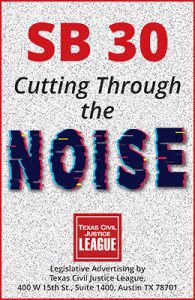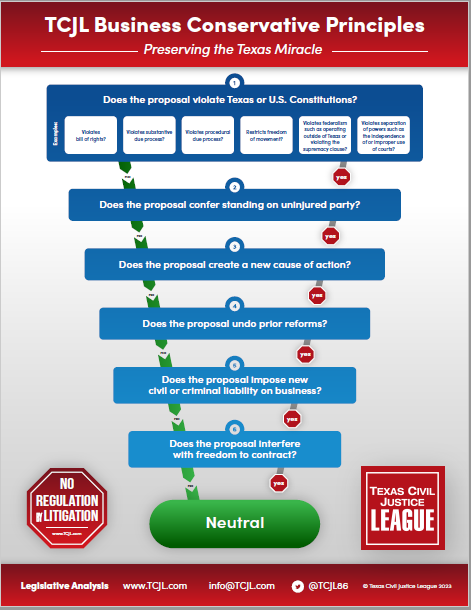SB 30 died in Conference Committee 5-30-25
HB 4806 died in House JCJ 5-7-25
Nuclear Verdicts
Please attend and sign a card FOR HB 4806. If you cannot attend the hearing or send someone to sign a card, you may enter public comments of support here: https://comments.house.texas.gov/home?c=c330
House Judiciary & Civil Jurisprudence
7:00am, Wednesday, May 7, 2025
E2.030
Hearing Notice
Video Link
Public testimony only will be heard from 7:00 AM until the Committee stands in recess for the House floor session and will be limited to two (2) minutes per witness.
Invited testimony only will be heard after the Committee reconvenes following the House floor session.
SB 30: Cutting Through the Noise on Medical, Noneconomic Damages
The load of misinformation about SB 30 currently inundating the Legislature not only falsely represents or distorts the actual language in the bill, but it wrongly accuses legislators who support the legislation of abandoning injured persons by eliminating causes of action and capping damages. It’s one thing to have a reasoned policy debate about these issues. It’s quite another to levy personal attacks on people of good faith who are trying to address a real inbalance in the civil justice system. This phenomenon is nothing new—we saw it in 1987, 1995, and 2003 as well—but that doesn’t make it an acceptable means by which to express opposition to either the specific language of the bill or its public policy objective.
So in what specific ways does SB 30 impact civil actions for personal injury? The bill has two parts. One part addresses the manner in which evidence of health care expenses arising from a claimant’s injury and alleged to have been caused by a defendant’s conduct are handled in discovery and at trial. That’s right: evidence of health care expenses actually paid or incurred, not limitations or caps on health care expenses. There has been much hue and cry that the bill makes it harder for claimants to recover those expenses. In our view, much of this angst comes from the bill exposing current practices that some use to evade the “paid or incurred” provision added to the law in 2003 and hide what they are doing from the jury. Since that time, it is undeniable that we have seen a proliferation of so-called “letters of protection,” which are agreements between lawyers and a health care providers to pay the providers out of a settlement or judgment in the lawsuit and not to bill third-party payors (private insurance or government payors). Along with this questionable scheme, whose only purpose is to boost expenses far beyond the contract reimbursement rates prevailing in the market, referral agreements and arrangements under which providers rebate a portion of their reimbursement to somebody else (perhaps a third-party litigation funder, the claimant’s lawyer or even the claimant) result in an assembly-line process for vastly inflating medical costs in the litigation context beyond any reasonable level.
It is true that SB 30 includes a “backstop” designed to put some guardrails on the process that will ensure some level of predictability and insurability of risk for potential defendants. Unfortunately, there is no perfect measure of what the health care market actually is, short of an all-claims data base that is comprehensive and granular enough to identify the actual reimbursement rates for health care services of all types. Such a data base is in the process of development and may be available for use in litigation in the near future. In the meantime, the current version SB 30 establishes the outer limit at 300 percent of the Medicare fee schedule for a particular service. In other words, the bill states that a party may recover three times the amount Medicare pays for the same service in a non-litigation context. It simply makes no sense, either from a health care finance or civil justice fairness point of view, to have one market for health care services in lawsuits and another for everything else. To the extent that a “free market” for health care services exists, that market is defined by what a third-party payor, whether private or public, is willing to pay and what a provider is willing to accept. Just because an injury results in a lawsuit, treatment for that injury should not be exempt from the market. In fact, to allow such an exemption is true socialized medicine because it makes everybody else pay non-market fees (generated by lawyers and providers alike) in a privileged class of cases and to a privileged class of people.
Let us be perfectly clear about this backstop issue. Opponents of the bill claim that it acts as a “cap” on medical damages. This claim is false. SB 30 merely provides that if a health care provider who treats a plaintiff for alleged injuries caused by the defendant does not wish to be deposed or testify at trial about the reasonableness of the provider’s charges, then the defendant may not controvert charges up to the 300% threshold. Put another way, SB 30 offers the provider a safe harbor from the litigation if the provider chooses to take advantage of it. That’s it. No cap. No obfuscation.
The second part of the bill addresses damages for physical and emotional pain and suffering, otherwise known as “noneconomic damages.” Despite an avalanche of advertising and mass text messaging claiming that SB 30 somehow caps such damages or limits a legitimately injured party’s recovery of such damages, the truth of the matter is that SB 30 largely codifies the plurality opinion of the Texas Supreme Court in a case called Gregory v. Chohan, 670 S.W.3d 546 (Tex. 2023). As Chief Justice Blacklock observed in the opinion, “We must insist that every aspect of our legal system—including the way we compensate grieving families for the wrongful death of a loved one—yields rational and non-arbitrary results based on evidence and reason, to the extent possible. Any system that countenances the arbitrary ‘picking numbers out of a hat’ approach to compensatory damages is not providing the rational process of law that we are obligated to provide, or at least to strive for” (emphasis added). In answer to critics of SB 30 who argue that the bill is unconstitutional because it restricts a jury’s discretion to award whatever it wants, Justice Blacklock reiterated that a long line of Texas Supreme Court authority “make[s] clear that the jury’s discretion is by no means unlimited and that the amount awarded must be supported by evidence.”
Rational process. Evidence and reason. By no means unlimited. All that SB 30 does is put these dictates into statute. The bill requires, for example, that future damages and future loss of earnings must be “reasonably probable.” Hard to argue with that. It defines “physical pain and suffering” and “emotional pain and anguish” to include all of the elements those terms have long meant in the common law: loss of consortium, loss of companionship and society, loss of enjoyment of life, disfigurement, physical impairment. As to physical pain and suffering, the bill requires a rational connection between the pain and suffering and an “observable injury, disfigurement, or impairment” that “is shown to exist through objectively verifiable medical evaluation or testing” (emphasis added). As to mental or emotional pain or anguish, SB 30 codifies the Supreme Court’s “substantial disruption of the claimant’s daily routine” test and includes what you would expect to see: loss of consortium, loss of companionship and society, loss of enjoyment of life, disfigurement, physical impairment.
If SB 30 merely puts what the Supreme Court has already said into a statute, why bother? Opponents asked the same question in 1995, when the Legislature codified the Court’s standards for awarding punitive damages. Of course, the Legislature included a cap on punitive damages as well, but SB 30 pointedly does not and could not without a three-fifths vote of both chambers. The purposes of codifying standards and definitions are: (1) to ensure long-term predictability and stability against future changes in the Court that might result in sudden change to the law (as repeatedly occurred in the 1980s); (2) to firmly impress upon trial courts and lawyers that they better stick to the statutory definitions or risk reversible error by not doing so; (3) to make sure that jury arguments stay within legal guardrails and not make appeals to irrational or inflammatory claims and statements (which the Gregory case condemns and SB 30 addresses by making such non-evidence-based arguments reversible error); and (4) to promote uniformity and consistent in judicial interpretations of the law. That’s it. That’s what SB 30 does with regard to noneconomic damages. There is no conspiracy, no hidden agenda. The bill simply outlines what the jury needs to know in order to reach a more objective, rational, and evidence-based determination of what are intrinsically subjective damages to begin with.
The virulence of the opposition to SB 30 has far more to do with the ways in which personal injury practice currently works than it does with promoting fairness and transparency in the system. If the Legislature enacts the bill, it will result in Texas juries being given the relevant information they need in order to make reasoned decisions that will hold up on appeal. It would seem to make no sense for the system to churn out huge verdicts that get overturned anyway, or at least that is what some of the opponents would have you think. Why do anything if the Supreme Court is just going to throw out these verdicts? For the simple reason that “nuclear” verdicts set the market. They make it impossible to evaluate risk. They force Texas businesses to take on more exposure at far higher costs than would exist if the verdicts were right in the first place. So why don’t we just design the system to produce the right result from the get-go? SB 30 does just that. The sky is not falling and will not fall. Legitimate claims will be paid. People who are hurt will be fairly and reasonably compensated, as the law requires. We will respect a jury’s intelligence, time, and service by giving them the relevant information straight. We will make the civil justice system operate faster and more efficiently. We will maintain a tort liability climate that is sustainable for both Texas businesses and deserving claimants.
Of course, SB 30 will never be acceptable to a sizable segment of the bar. We are seeing that play out in the social media frenzy surrounding it. As for the politics, we will simply say that in nearly 40 years of civil justice reform efforts, we are not aware of a single elected official who has suffered defeat because he or she supported reasonable reforms.
SB 30 by Senator Charles Schwertner
HB 4806 by Representative Greg Bonnen
Lone Star Economic Alliance lseatx.org
